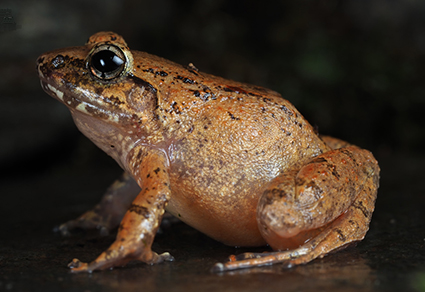Abstract
Limnonectes liui (Yang, 1983) is a poorly known frog from Yunnan Province, China, with a confusing taxonomic history. We use mitochondrial (mt) DNA sequence data from newly collected specimens to reconstruct the phylogenetic position of the species. Limnonectes liui was found to be deeply nested within the geographically widespread dicroglossid frog L. limborgi (Sclater, 1892), verifying its placement within the genus Limnonectes but casting doubt on its distinction as a species. Morphological comparisons of the holotype and newly collected specimens of L. liui to specimens of L. limborgi from across its range also corroborated the hypothesis that these two species are conspecific, and we recommend treating L. liui as a junior synonym of L. limborgi. Our study underscores the importance of making comparisons with species found beyond a country’s border when describing new species.
References
Borah, M.M., Bordoloi, S., Purkayastha, J., Das, M., Dubois, A. & Ohler, A. (2013) Limnonectes (Taylorana) medogensis (Fei, Ye & Huang, 1997) from Arunachal Pradesh (India), and on the identity of some diminutive ranoid frogs (Anura: Dicroglossidae, Occidozygidae). Herpetozoa, 26 (1/2), 39–48.
Burland, T.G. (2000) DNASTAR’s Lasergene sequence analysis software. Molecular Biology and Evolution, 132, 71–91. https://doi.org/10.1385/1-59259-192-2:71
Darriba, D., Taboada, G.L., Doallo, R. & Posada, D. (2012) jModelTest 2: more models, new heuristics and parallel computing. Nature methods, 9 (8), 772–772. https://doi.org/10.1038/nmeth.2109
Dubois, A. (1987) Miscellanea taxinomica batrachologica (I). Alytes, 5, 7–95.
Fei, L., Hu, S.Q., Ye, C.Y. & Huang, Y.Z. (2009) Fauna Sinica. Amphibia. Vol. 2 Anura. Science Press, Beijin, 957 pp.
Fei, L., Ye, C.Y., Huang, Y.Z. & Liu, M.Y. (1999) Atlas of amphibians of China. Henan Science and Technology Press, Zhengzhou, Henan, 432 pp.
Inger, R.F. & Stuart, B.L. (2010) Systematics of Limnonectes (Taylorana) Dubois. Current Herpetology, 29 (2), 51–68. https://doi.org/10.3105/018.029.0201
Köhler, G., Vargas, J., Than, N.L., Schell, T., Janke, A., Pauls, S.U. & Thammachoti, P. (2021) A taxonomic revision of the genus Phrynoglossus in Indochina with the description of a new species and comments on the classification within Occidozyginae (Amphibia, Anura, Dicroglossidae). Vertebrate Zoology, 71, 1–26. https://doi.org/10.3897/vz.71.e60312
Kozlov, A.M., Darriba, D., Flouri, T., Morel, B. & Stamatakis, A. (2019) RAxML-NG: a fast, scalable and user-friendly tool for maximum likelihood phylogenetic inference. Bioinformatics, 35 (21), 4453–4455. https://doi.org/10.1093/bioinformatics/btz305
Kumar, S., Stecher, G., Li, M., Knyaz, C. & Tamura, K. (2018) MEGA X: molecular evolutionary genetics analysis across computing platforms. Molecular biology and evolution, 35 (6), 1547–1549. https://doi.org/10.1093/molbev/msy096
Ohler, A. (2007) New synonyms in specific names of frogs (Raninae) from the border regions between China, Laos and Vietnam. Alytes, 25 (1), 55–74. https://doi.org/10.1093/molbev/msy096
Ronquist, F., Teslenko, M., Van Der Mark, P., Ayres, D.L., Darling, A., Höhna, S. & Huelsenbeck, J.P. (2012) MrBayes 3.2: efficient Bayesian phylogenetic inference and model choice across a large model space. Systematic biology, 61 (3), 539–542. https://doi.org/10.1093/sysbio/sys029
Sclater, W.L. (1892) On some specimens of frogs in the Indian Museum, Calcutta, with descriptions of several new species. Proceedings of the zoological Society of London, 1892, 341–348.
Yang, D. (1983) A new species of the genus Platymantis (Amphibia: Ranidae). Acta Herpetologica Sinica, 2 (2), 53–56.
Zhao, E.M. & Adler, K. (1993) Herpetology of China. Contributions to herpetology, 10. Society for the Study of Amphibians and Reptiles in cooperation with ChineseSociety for the Study of Amphibians and Reptiles, Oxford, Ohio, 522 pp.

